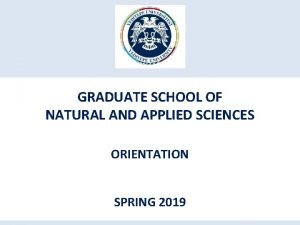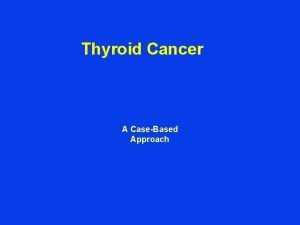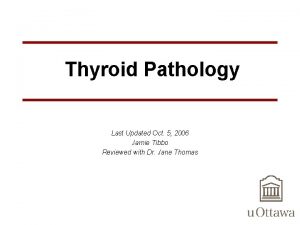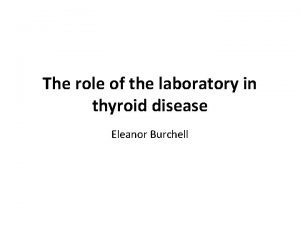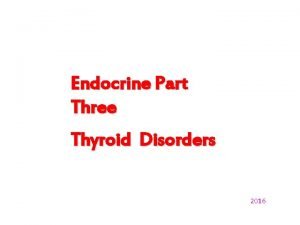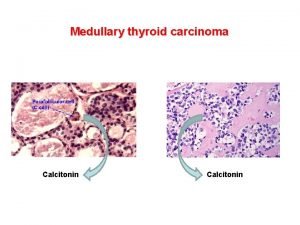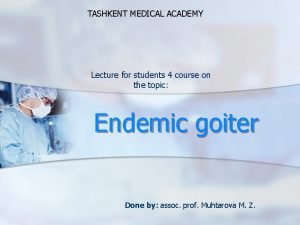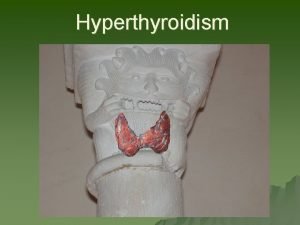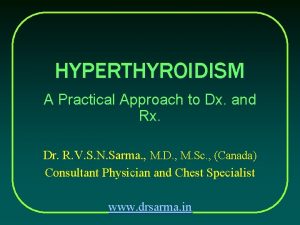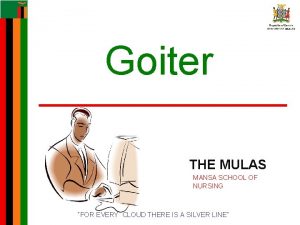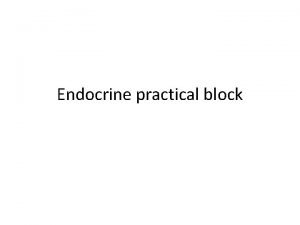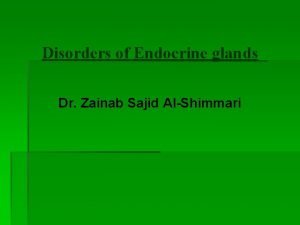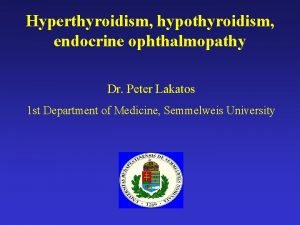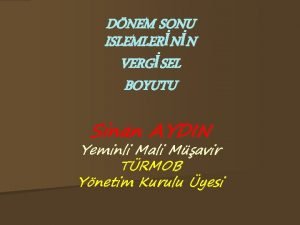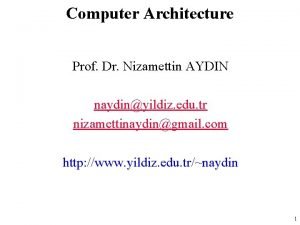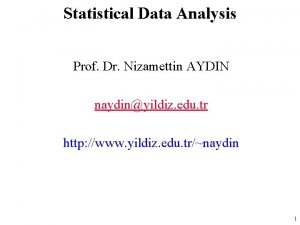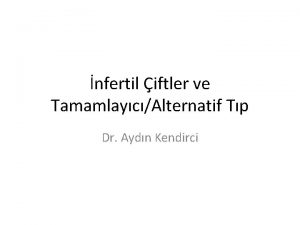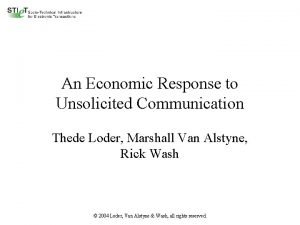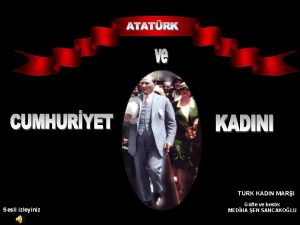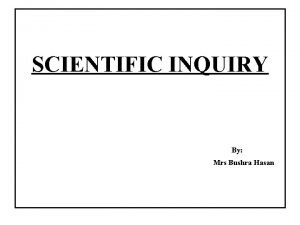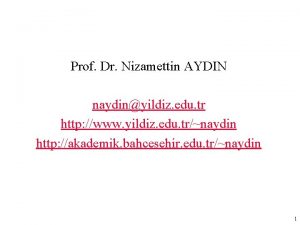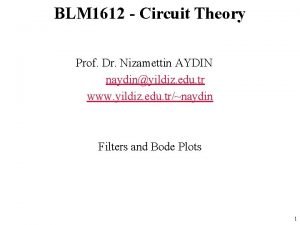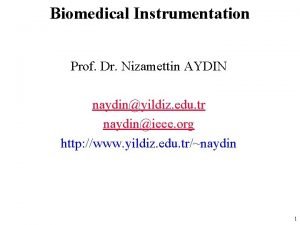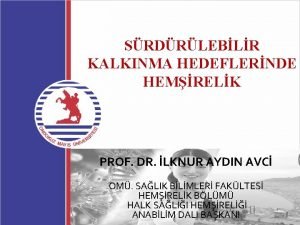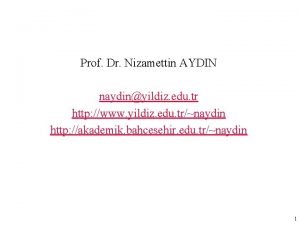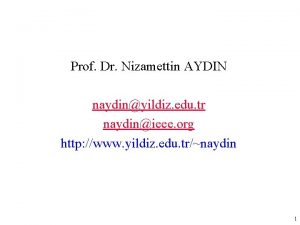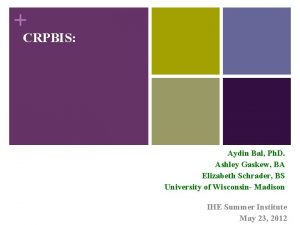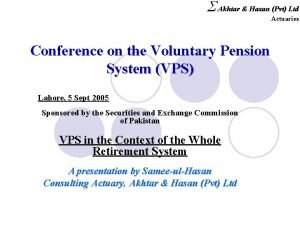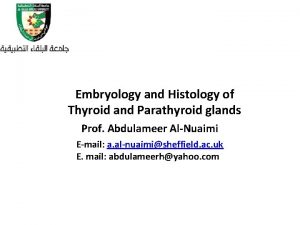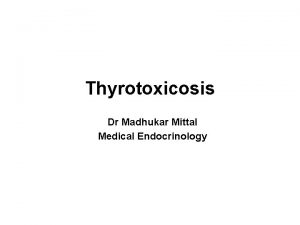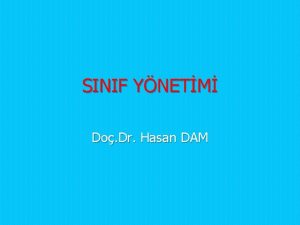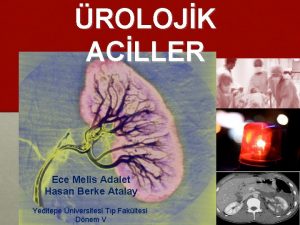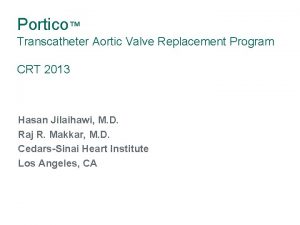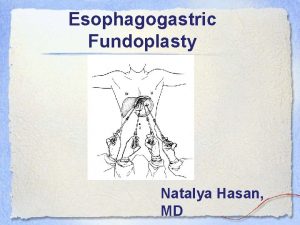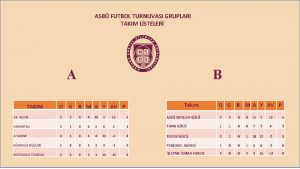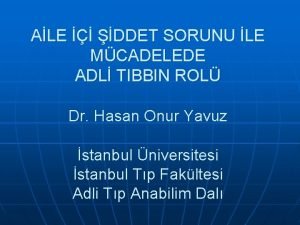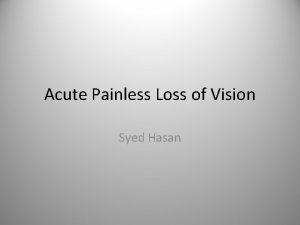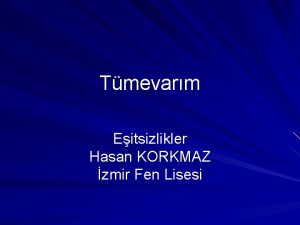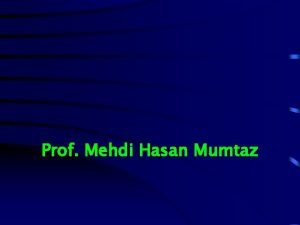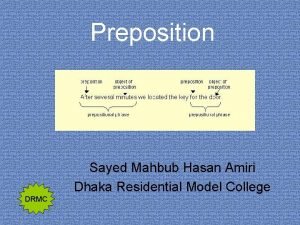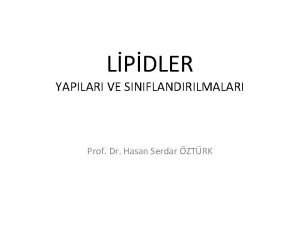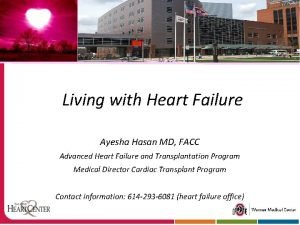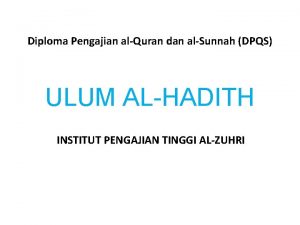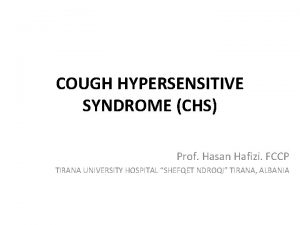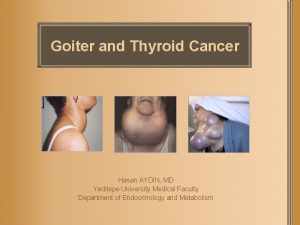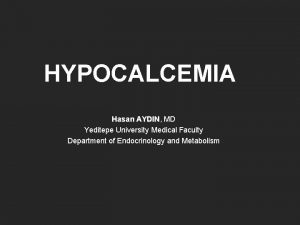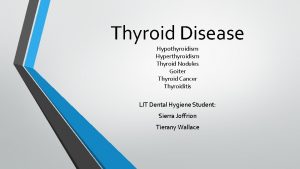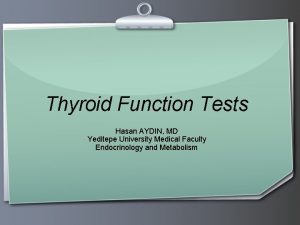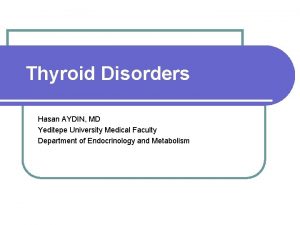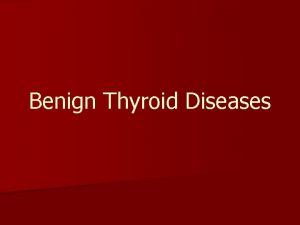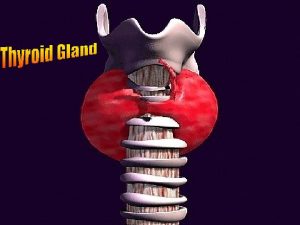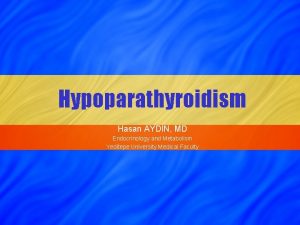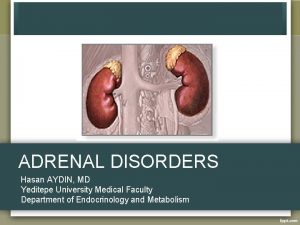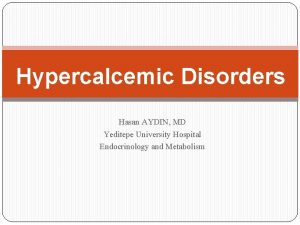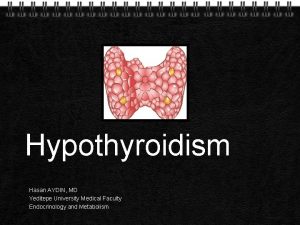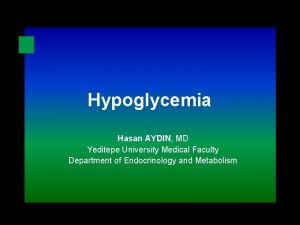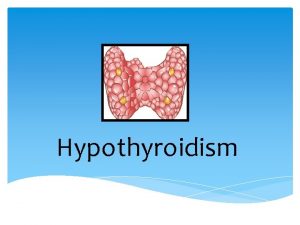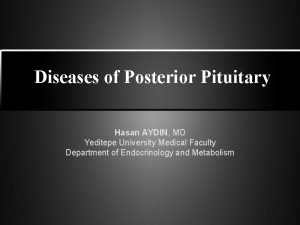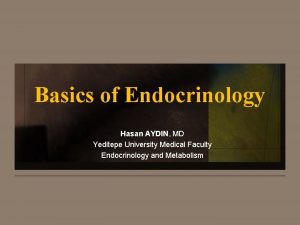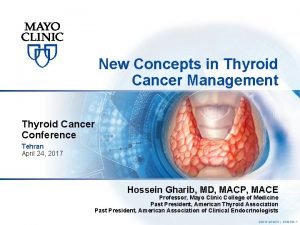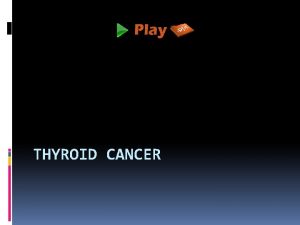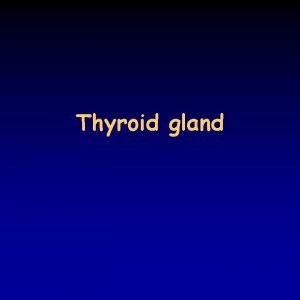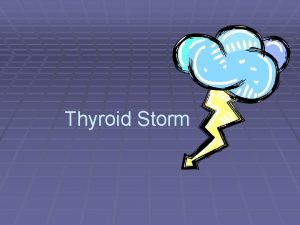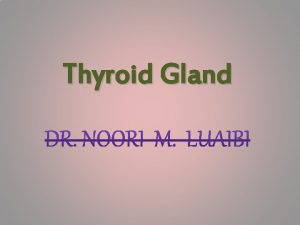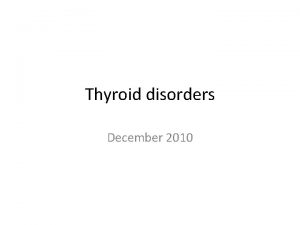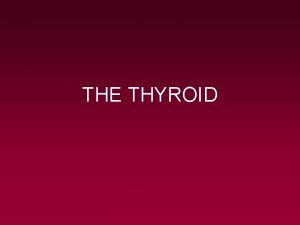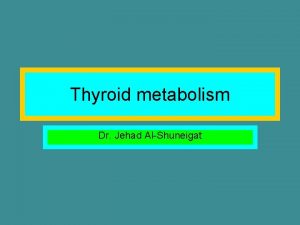Goiter and Thyroid Cancer Hasan AYDIN MD Yeditepe





































































- Slides: 69

Goiter and Thyroid Cancer Hasan AYDIN, MD Yeditepe University Medical Faculty Department of Endocrinology and Metabolism

Goiter

Definitions Goiter is a diffuse or nodular enlargement of the thyroid gland resulting from excessive replication of benign thyroid epithelial cells. A thyroid nodule is a discrete lesion within the thyroid gland that is palpably and/or ultrasonog- raphically distinct from the surrounding thyroid parenchyma Incidentalomas are non-palpable nodules incidentally discovered on USG or other radiological imaging performed for other reasons

Thyroid Structure - Diffuse - Nodular Function - Euthyroid - Hyperthyroid - Hypothyroid

Prevalence • Large population studies-Framingham study showed clinically significant nodules in 6. 4% women and 1. 5% men ages 30 -59 (total 4. 2%) but thought to be significantly understated • Ultrasounds- 20% to 76% of females had at least one thyroid nodule on ultrasound • Autopsy surveys show 37 to 57% of patients with thyroid nodules

Rate of Carcinoma in Thyroid Nodules • Significant selection bias in surgical series • USA: Pts with nodules were referred to surgery without biopsy and 6. 5% of excised nodules were carcinomas • Italy: 2327 pts with nodules were evaluated by FNA and of those 391 were selected for surgery. Carcinomas were found in 5% of total

Causes of Thyroid Nodules • Benign- >90% ▫ Multinodular goiter (colloid adenoma) ▫ Hashimoto’s (chronic lymphocytic) thyroiditis ▫ Cysts: colloid, simple, or hemorrhagic-7 -14% can be malignant- most commonly papillary ca with a cystic component with most increased size 2 -4 cm ▫ Follicular Adenoma Macrofollicular adenoma Microfollicular or cellular Hurthle-cell (oxyphil cell) adenomas- macro or microfollicular • Malignant -about 6% ▫ Papillary ▫ Follicular Minimally or widely invasive Oxyphilic type ▫ Medullary ▫ Anaplastic ▫ Primary thyroid lymphoma ▫ Metastatic carcinoma

Nodular Goiter

Pathogenesis • Dyshormonogenesis or severe iodine deficiency • Impaired hormone synthesis • Secondarily and increase in TSH secretion. • TSH induces diffuse thyroid hyperplasia, followed by focal hyperplasia with necrosis and hemorrhage, finally the development of new areas of focal hyperplasia. • A clone of cells that may or may not be able to pick up iodine or synthesize thyroglobulin.

NODULAR GOITER Presentation • Asymptomatic ▫ Neck mass discovered by patient or physician ▫ Abnormal CXR • Symptomatic �Pressure symptoms �Hoarseness �Thyrotoxicosis

Whan a thyroid nodule is detected Malignant? Hyperfunctional? • • Thyroid USG : Number and dimentions of nodules TSH and f. T 4

NODULAR GOITER Suspicious Nodule or Goiter • High suspicion ▫ ▫ ▫ ▫ Family history of medullary thyroid carcinoma Rapid tumor growth A nodule that is very firm or hard Fixation of the nodule to the adjacent structures Paralysis of the vocal cord Regional lymphadenopathy Distant metastasis ▫ ▫ ▫ Age of either<20 or >70 years Male sex History of head and neck irradiation A nodule >4 cm in diameter or partially cystic Symptoms of compression, including dysphagia, dysphonia, hoarseness, dyspnea, and cough • Moderate suspicion

Differentiation of Benign & Malign Lesions

NODULAR GOITER Evaluation • • • TSH FT 4, T 3 Radionuclide Scan / RAIU US CT Scan (without contrast) FNA biopsy

Ultrasound • Provides considerable anatomic information but no functional information • Determine the volume of a nodule, multicentricity and whether it is cystic or solid- often performed before FNA • Extremely useful in also following patients being managed conservatively for possible increasing size of lesion • Unable, however, to accurately predict the diagnosis of solid nodules

Ultrasound • Cystic lesion are reassuring but only 1 -5% of total thyroid nodules • In addition, as many as 25% of well-differentiated thyroid cancers had cystic components and up to 60 -70% of all nodules • Physician correlate the nuclear medicine and U/S finding and determine the function of the particular nodule • Additional nodules can be found 20 -48% of patients • Many times the U/S findings differ from the physical exam, in one retrospective series up to 63% of the time


Ultrasound • Ultrasonographic Cancer Risk Factors for a Thyroid Nodule ▫ ▫ ▫ hypoechogenicity, microcalcifications, irregular margins, increased nodular flow visualized by Doppler, the evidence of invasion or regional lymphadenopathy

NODULAR GOITER FNA Evaluation • Biopsy all accessible nodule(s) • Biopsy suspicious nodule(s) cold on scan; firm by palpation; growing in size • Results less reliable in large goiters • Most common diagnosis is “colloid nodule”

FNA • Simple, safe office procedure • Tissue sample obtained by 25 gauge needle • With experience adequate sample may be obtained in 90 -97% of aspirates of solid nodules • False negative rate (FNA benign but nodule turn out malignant) is 0 -5% usually due to sampling error • False positive rates (malignant but turns out benign) <5% due to focal hyperplasia in a macrofollicular adenoma or cellular atypia in a degenerating adenoma

FNA Evaluation


FNA Evaluation

FNA results • Malignant- pt needs to have surgical management • Benign- observation with interval ultrasounds and clinical examinations • Indeterminate- radioisotope scan- perform suppression scan and if cold proceed to surgical management- if hot nodule consider observation • Non diagnostic- repeat FNA or U/S guided FNA

Functionality in Thyroid Nodules TSH Hyperthyroid <0. 5 m. IU/ml Thyroid scintigraphy Euthyroid 0. 5 -4 m. IU/ml Hypothyroid >4 m. IU/ml

Imaging- Thyroid Scintigraphy • Utilizes iodine or technetium-99 m pertechnate- more is taken up and organified by functional tissue • Non-functioning thyroid nodule is cold and mandates further work-up by FNA • The scan is often used in working up nodules in patients with low TSH levels • Only slightly more than one-half of the excised malignant thyroid nodules appear cold because the scan is 2 -D there is apposition of normal thyroid tissue next to abnormal tissue

• Also although 80% of nodules greater than 2 cm appear cold- smaller nodules can be indeterminate • Malignancy has been shown to occur 15 -20% of “cold” nodules and, additionally, in 5 -9% of nodules with uptake that is “warm” or “hot” • Thyroid scintigraphy has fallen out of favordefinitely questions about how cost-effective it is for routine evaluation for patients with nodules


Thyroid nodule T USG <1 cm No risk factor Follow >1 cm or any risk factor İİAB TSH, T 4 Hyperthyroid Tiroid scintigraphy Eutiroid Hypothyroid


THYROID CANCERS

Neoplasms of the Thyroid (from WHO Classification) II. Malignant Tumors A. Differentiated 1. Papillary adenocarcinoma I. Adenomas a. Pure papillary adenocarcinoma A. Follicular b. Mixed papillary and follicular ca 1. Colloid variant (variants including tall cell, follicular, oxyphyl, 2. Embryonal solid) 3. Fetal 2. Follicular adenocarcinomas (variants: 4. Hurthle cell variant "malignan adenoma", Hurthle cell carcinoma or B. Papillary (probably malignant)oxyphil carcinoma, clear-cell carcinoma, insular carcinoma C. Teratoma B. Medullary carcinoma- (not a tumor of follicular cells) C. Undifferentiated 1. Small cell (to be differentiated from lymphoma) 2. Giant cell 3. Carcinosarcoma D. Miscellaneous 1. Lymphoma, sarcoma 2. Squamous cell epidermoid ca 3. Fibrosarcoma 4. Mucoepithelial ca. 5. Metastatic tumor

THYROID CANCER • Papillary (mixed papillary and follicular) 75% • Follicular carcinoma 16% • Medullary carcinoma 5% • Undifferentiated carcinomas 3% • Miscellaneous (lymphoma, fibrosarcoma, 1% squamous cell carcinoma, malignant hemangioendothelioma, teratomas, and metastatic carcinomas)

Classification of Malignant Thyroid Neoplasms • Papillary carcinoma �Follicular variant �Tall cell �Diffuse sclerosing �Encapsulated • Follicular carcinoma �Overtly invasive �Minimally invasive • Hurthle cell carcinoma • Anaplastic carcinoma �Giant cell �Small cell • Medullary Carcinoma • Miscellaneous Sarcoma Lymphoma Squamous cell carcinoma Mucoepidermoid carcinoma Clear cell tumors Pasma cell tumors Metastatic Direct extention Kidney Colon Melanoma

Well-Differentiated Thyroid Carcinomas (WDTC) - Papillary, Follicular, and Hurthle cell • Pathogenesis - unknown • Papillary has been associated with the RET proto -oncogene but no definitive link has been proven (Geopfert, 1998) • Certain clinical factors increase the likelihood of developing thyroid cancer �Irradiation - papillary carcinoma �Prolonged elevation of TSH (iodine deficiency) - follicular carcinoma (Goldman, 1996) �relationship not seen with papillary carcinoma �mechanism is not known

WDTC - Papillary Carcinoma • 60%-80% of all thyroid cancers (Geopfert, 1998, Merino, 1991) • Histologic subtypes �Follicular variant �Tall cell �Columnar cell �Diffuse sclerosing �Encapsulated • Prognosis is 80% survival at 10 years (Goldman, 1996) • Females > Males • Mean age of 35 years (Mazzaferri, 1994)

WDTC - Papillary Carcinoma (continued…) • Lymph node involvement is common �Major route of metastasis is lymphatic � 46%-90% of patients have lymph node involvement (Goepfert, 1998, Scheumann, 1984, De Jong, 1993) �Clinically undetectable lymph node involvement does not worsen prognosis (Harwood, 1978)

WDTC - Papillary Carcinoma (Continued…) • Microcarcinomas - a manifestation of papillary carcinoma �Definition - papillary carcinoms smaller than 1. 0 cm �Most are found incidentally at autopsy �Autopsy reports indicate that these may be present in up to 35% of the population (Mazzaferri, 1993) �Usually clinically silent �Most agree that the morbidity and mortality from microcarcinoma is minimal and near that of the normal population �One study showed a 1. 3% mortality rate (Hay, 1990)

WDTC - Papillary Carcinoma (continued…) • Pathology �Gross - vary considerably in size - often multi-focal - unencapsulated but often have a pseudocapsule �Histology - closely packed papillae with little colloid - psammoma bodies - nuclei are oval or elongated, pale staining with ground glass appearanc Orphan Annie cells

WDTC - Follicular Carcinoma • • • 20% of all thyroid malignancies Women > Men (2: 1 - 4: 1) (Davis, 1992, De Souza, 1993) Mean age of 39 years (Mazzaferri, 1994) Prognosis - 60% survive to 10 years (Geopfert, 1994) Metastasis - angioinvasion and hematogenous spread � 15% present with distant metastases to bone and lung • Lymphatic involvement is seen in 13% (Goldman, 1996)

WDTC - Follicular Carcinoma (Continued…) • Pathology �Gross - encapsulated, solitary �Histology - very well-differentiated (distinction between follicular adenoma and carcinomaid difficult) - Definitive diagnosis - evidence of vascular and capsular invasion �FNA and frozen section cannot accurately distinquish between benign and malignant lesions

WDTC - Hurthle Cell Carcinoma • Variant of follicular carcinoma • First described by Askanazy �“Large, polygonal, eosinophilic thyroid follicular cells with abundant granular cytoplasm and numerous mitochondria” (Goldman, 1996) • Definition (Hurthle cell neoplasm) - an encapsulated group of follicular cells with at least a 75% Hurthle cell component • Carcinoma requires evidence of vascular and capsular invasion • 4%-10% of all thyroid malignancies (Sessions, 1993)

WDTC - Hurthle Cell Carcinoma (Continued…) • Women > Men • Lymphatic spread seen in 30% of patients (Goldman, 1996) • Distant metastases to bone and lung is seen in 15% at the time of presentation

WDTC - Prognosis • Based on age, sex, and findings at the time of surgery (Geopfert, 1998) • Several prognostic schemes represented by acronyms have been developed by different groups: �AMES (Lahey Clinic, Burlington, MA) �GAMES (Memorial Sloan-Kettering Cancer Center, New York, NT) �AGES (Mayo Clinic, Rochester, MN)

WDTC - Prognosis (Continued…) • Depending on variables, patients are categorized in to one of the following three groups: 1) Low risk group - men younger than 40 years and women younger than 50 years regardless of histologic type - recurrence rate -11% - death rate - 4% (Cady and Rossi, 1988)

WDTC - Prognosis (Continued…) � 1) Intermediate risk group - Men older than 40 years and women older than 50 years who have papillary carcinoma - recurrence rate - 29% - death rate - 21% � 2) High risk group - Men older than 40 years and women older than 50 years who have follicular carcinoma - recurrence rate - 40% - death rate - 36%

Medullary Thyroid Carcinoma • 10% of all thyroid malignancies • 1000 new cases in the U. S. each year • Arises from the parafollicular cell or C-cells of the thyroid gland �derivatives of neural crest cells of the branchial arches �secrete calcitonin which plays a role in calcium metabolism

Medullary Thyroid Carcinoma (Continued…) • Developes in 4 clinical settings: �Sporadic MTC (SMTC) �Familial MTC (FMTC) �Multiple endocrine neoplasia IIa (MEN IIa) �Multiple endocrine neoplasia IIb (MEN IIb)

Medullary Thyroid Carcinoma (continued…) • Sporadic MTC: � 70%-80% of all MTCs (Colson, 1993, Marzano, 1995) �Mean age of 50 years (Russell, 1983) � 75% 15 year survival (Alexander, 1991) �Unilateral and Unifocal (70%) �Slightly more aggressive than FMTC and MEN IIa � 74% have extrathyroid involvement at presentation (Russell, 1983)

Medullary Thyroid Carcinoma (Continued…) • Familial MTC: �Autosomal dominant transmission �Not associated with any other endocrinopathies �Mean age of 43 �Multifocal and bilateral �Has the best prognosis of all types of MTC � 100% 15 year survival (Farndon, 1986)

Medullary Thyroid Carcinoma (continued…) • Multiple endocrine neoplasia IIa (Sipple’s Syndrome): �MTC, Pheochromocytoma, parathyroid hyperplasia �Autosomal dominant transmission �Mean age of 27 � 100% develop MTC (Cance, 1985) � 85%-90% survival at 15 years (Alexander, 1991, Brunt, 1987)

Medullary Thyroid Carcinoma (continued…) • Multiple endocrine neoplasia IIb (Wermer’s Syndrome, MEN III, mucosal syndrome): �Pheochromocytoma, multiple mucosal neuromas, marfanoid body habitus � 90% develop MTC by the age of 20 �Most aggressive type of MTC � 15 year survival is <40%-50% (Carney, 1979)

Medullary Thyroid Carcinoma (continued…) • Diagnosis �Labs: 1) basal and pentagastrin stimulated serum calcitonin levels (>300 pg/ml) 2) serum calcium 3) 24 hour urinary catecholamines (metanephrines, VMA, normetanephrines) 4) carcinoembryonic antigen (CEA) �Fine-needle aspiration �Genetic testing of all first degree relatives ▫ RET proto-oncogene

Anaplastic Carcinoma of the Thyroid • • Highly lethal form of thyroid cancer Median survival <8 months (Jereb, 1975, Junor, 1992) 1%-10% of all thyroid cancers (Leeper, 1985, Li. Volsi, 1987) Affects the elderly (30% of thyroid cancers in patients >70 years) (Sou, 1996) • Mean age of 60 years (Junor, 1992) • 53% have previous benign thyroid disease (Demeter, 1991) • 47% have previous history of WDTC (Demeter, 1991)

Anaplastic Carcinoma of the Thyroid • Pathology �Classified as large cell or small cell �Large cell is more common and has a worse prognosis �Histology - sheets of very poorly differentiated cells little cytoplasm numerous mitoses necrosis extrathyroidal invasion

Management • Surgery is the definitive management of thyroid cancer, excluding most cases of ATC and lymphoma • Types of operations: ▫ lobectomy with isthmusectomy - minimal operation required for a potentially malignant thyroid nodule ▫ total thyroidectomy - removal of all thyroid tissue - preservation of the contralateral parathyroid glands ▫ subtotal thyroidectomy - anything less than a total thyroidectomy

Management (WDTC) - Papillary and Follicular • Subtotal vs. total thyroidectomy

Management (WDTC)- Papillary and Follicular (continued…) • Rationale for total thyroidectomy � 1) 30%-87. 5% of papillary carcinomas involve opposite lobe (Hirabayashi, 1961, Russell, 1983) � 2) 7%-10% develop recurrence in the contralateral lobe (Soh, 1996) � 3) Lower recurrence rates, some studies show increased survival (Mazzaferri, 1991) � 4) Facilitates earlier detection and tx for recurrent or metastatic carcinoma with iodine (Soh, 1996) � 5) Residual WDTC has the potential to dedifferentiate to ATC

Management (WDTC) - Papillary and Follicular (Continued…) • Rationale for subtotal thyroidectomy � 1) Lower incidence of complications ▫ Hypoparathyroidism (1%-29%) (Schroder, 1993) ▫ Recurrent laryngeal nerve injury (1%-2%) (Schroder, 1993) ▫ Superior laryngeal nerve injury � 2) Long term prognosis is not improved by total thyroidectomy (Grant, 1988)

Management (WDTC) - Papillary and Follicular (continued) • Indications for total thyroidectomy � 1) Patients older than 40 years with papillary or follicular carcinoma � 2) Anyone with a thyroid nodule with a history of irradiation � 3) Patients with bilateral disease

Management (WDTC) - Papillary and Follicular (continued) • Managing lymphatic involvement �pericapsular and tracheoesophageal nodes should be dissected and removed in all patients undergoing thyroidectomy for malignancy �Overt nodal involvement requires exploration of mediastinal and lateral neck �if any cervical nodes are clinically palpable or identified by MR or CT imaging as being suspicious a neck dissection should be done (Goldman, 1996) �Prophylactic neck dissections are not done (Gluckman)

Management (WDTC) - Papillary and Follicular (continued) • Postoperative therapy/follow-up ▫ Radioactive iodine (administration) �Scan at 4 -6 weeks postop �repeat scan at 6 -12 months after ablation �repeat scan at 1 year then. . . �every 2 years thereafter

Management (WDTC) - Papillary and Follicular (continued) • Postoperative therapy/follow-up ▫ Thyroglobulin (TG) (Gluckman) �measure serum levels every 6 months �Level >30 ng/ml are abnormal ▫ Thyroid hormone suppression (control TSH dependent cancer) (Goldman, 1996) �should be done in - 1) all total thyroidectomy patients 2) all patients who have had radioactive ablation of any remaining thyroid tissue

Management (WDTC) - Hurthle Cell Carcinoma (continued) • Total thyroidectomy is recommended because: � 1) Lesions are often Multifocal � 2) They are more aggressive than WDTCs � 3) Most do not concentrate iodine

Management (WDTC) - Hurthle Cell Carcinoma (continued) • Postoperative management �Thyroid suppression �Measure serum thyroglobulin every 6 months �Postoperative radioactive iodine is usually not effective (10% concentrate iodine) (Clark, 1994)

Medullary Thyroid Carcinoma (Management) • Recommended surgical management �total thyroidectomy �central lymph node dissection �lateral jugular sampling ▫ if suspicious nodes - modified radical neck dissection • If patient has MEN syndrome �remove pheochromocytoma before thyroid surgery

Medullary Thyroid Carcinoma (Management) • Postoperative management �disease surveillance �serial calcitonin and CEA ▫ 2 weeks postop ▫ 3/month for one year, then… ▫ biannually �If calcitonin rises ▫ metastatic work-up ▫ surgical excision ▫ if metastases - external beam radiation

Anaplastic Carcinoma (Management) • Most have extensive extrathyroidal involvement at the time of diagnosis �surgery is limited to biopsy and tracheostomy • Current standard of care is: �maximum surgical debulking, possible �adjuvant radiotherapy and chemotherapy (Jereb and Sweeney, 1996)

Thank You
 Medivia
Medivia Coadsys exam yeditepe
Coadsys exam yeditepe Tr
Tr Thyroid cancer: a case-based approach
Thyroid cancer: a case-based approach Dr jamie tibbo
Dr jamie tibbo Thyroid scan
Thyroid scan Nursing management of thyroid cancer
Nursing management of thyroid cancer Medullary thyroid cancer
Medullary thyroid cancer Esmo guidelines thyroid cancer
Esmo guidelines thyroid cancer Toxic multinodular goiter
Toxic multinodular goiter Iodine deficiency goiter
Iodine deficiency goiter Multinodular goiter pathophysiology
Multinodular goiter pathophysiology Amiodarone thyroid toxicity
Amiodarone thyroid toxicity Multinodular goiter
Multinodular goiter Goiter classification
Goiter classification Enlarged thyroid gland
Enlarged thyroid gland Enlarged thyroid gland
Enlarged thyroid gland Dr peter lakatos
Dr peter lakatos Goiter
Goiter Histology thyroid gland
Histology thyroid gland Sinan aydın ymm
Sinan aydın ymm Prof. dr. nizamettin aydin
Prof. dr. nizamettin aydin Nizamettin aydin
Nizamettin aydin Aydın kendirci
Aydın kendirci Unsent message to aydin
Unsent message to aydin Sevil aydın
Sevil aydın Aydın bir türk kadınıyım
Aydın bir türk kadınıyım Xahra franklin
Xahra franklin Prof. dr. nizamettin aydin
Prof. dr. nizamettin aydin Prof. dr. nizamettin aydin
Prof. dr. nizamettin aydin Prof. dr. nizamettin aydin
Prof. dr. nizamettin aydin Coordination
Coordination Package diagram
Package diagram Aydin marine
Aydin marine Aydın başar
Aydın başar Nizamettin aydin
Nizamettin aydin Nazmi aydın
Nazmi aydın Aydin bal
Aydin bal Aydın kekemelik merkezi
Aydın kekemelik merkezi Akhtar and hasan
Akhtar and hasan Akhtar and hasan
Akhtar and hasan Berry's ligament thyroid
Berry's ligament thyroid Parathyroid tissue histology
Parathyroid tissue histology Dr madhukar mittal
Dr madhukar mittal Hasan dam
Hasan dam Hasan berke atalay
Hasan berke atalay Jude hasan
Jude hasan Zahid hasan diu
Zahid hasan diu Abdul qadir hasan baraja
Abdul qadir hasan baraja Dr hasan hafizur rahman
Dr hasan hafizur rahman What is diploid
What is diploid Natalya hasan
Natalya hasan Emir hasan ölmez
Emir hasan ölmez Hasan mohiaddin
Hasan mohiaddin Dr hasan onur yavuz
Dr hasan onur yavuz Sudden painless loss of vision
Sudden painless loss of vision Sead ujkani
Sead ujkani Hasan korkmaz ifl
Hasan korkmaz ifl Raja hasan saregamapa 2007
Raja hasan saregamapa 2007 Base deficit
Base deficit Hasan irfan khan
Hasan irfan khan Hasan amiri
Hasan amiri Hasan atsız
Hasan atsız Dr hasan hafizur rahman
Dr hasan hafizur rahman Amisco prozone
Amisco prozone Prof. dr. hasan serdar öztürk
Prof. dr. hasan serdar öztürk Ayesha hasan md
Ayesha hasan md Contoh hadis sahih lizatihi
Contoh hadis sahih lizatihi Dr hasan hafizi
Dr hasan hafizi Community based tourism in bangladesh
Community based tourism in bangladesh


